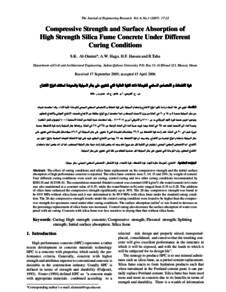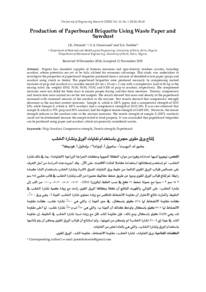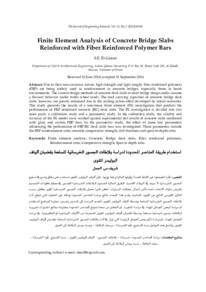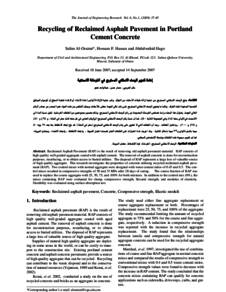Document
Compressive strength and surface absorption of high strength silica fume concrete under different curing conditions.
Contributors
Publisher
Sultan Qaboos University
Gregorian
2007
Language
English
Subject
English abstract
The effect of curing conditions and silica fume replacement on the compressive strength and the initial surface absorption of high performance concrete is reported. The silica fume contents were 5, 10, 15 and 20%, by weight of cement. Four different curing conditions were used: air curing, control curing and two other curing conditions recommended by BS8110 and ACI308-81. The cementitious material (binder) content was constant (400 kg/m3); the water/cement (w/c) ratio was also maintained at a constant value of 0.35; while the water/binder (w/b) ratio ranged from 0.35 to 0.28. The addition of silica fume enhanced the compressive strength significantly up to 30%. The 28-day compressive strength was found to be 69.9 MPa without silica fume and it was determined to be 89.9 MPa with silica fume under the standard curing condition. The 28-day compressive strength results under the control curing condition were found to be higher than the compressive strength for specimens cured under other curing conditions. The surface absorption (ml/m2.s) was found to decrease as the percentage replacement of silica fume was increased. Control curing also decreases the surface absorption of water compared with air curing. Concrete with silica fume was less sensitive to drying than that without silica fume.
Member of
ISSN
1726-6742
Resource URL
Citation
Al-Oraimi, S. K., Hago, A. W., Hassan, H. F., & Taha, R. (2007). Compressive strength and surface absorption of high strength silica fume concrete under different curing conditions. The Journal of Engineering Research, 4 (1), 17-22.
Arabic abstract
تجري في هذا البحث دراسة تأثير أنواع الإنضاج واستخدام السيليكا على قوة انضغاط والامتصاص السطحي المبدئي للخرسانة عالية الأداء. وقد استخدمت كميات من بخار السيليكا بنسبة 5 و10 و20 في المائة من وزن الاسمنت المستخدم، كما استخدمت أربع أنواع مختلفة من الإنضاج تضمنت : الإنضاج الهوائي والإنضاج المحكوم ونوعين آخرين حسبما قرره الكود البريطاني ب س 8110 والأمريكي أس ي 308 - 81. وقد استخدمت نسبة ثابتة من المادة الاسمنتية (400 كيلوجرام للمتر المكعب) ونسبة الماء إلى الاسمنت ثبتت عند 35 في المائة بينما غيرت نسبة الماء إلى المادة الرابطة من 35 إلى 28 في المائة. وبإضافة بخار السيليكا زادت قوة الانضغاط بنسبة كبيرة تصل إلى 30 في المائة، فقد زادت قوة الانضغاط من 96.9 ميغاباسكال للخرسانة التي لا تحتوي على بخار السيليكا إلى 89.9 ميغاباسكال للخرسانة التي تحتوي على بخار السيليكا باستخدام أنواع قياسية من الإنضاج. وقد وجد أن قوة الانضغاط بعد 28 يوما من الإنضاج المحكوم تزيد على قوة الانضغاط للعينات المنضجة بأنواع أخرى من الإنضاج. أما الامتصاص السطحي المبدئي (مليليتر في الثانية لكل متر مربع) فقد وجد أنه ينقص كلما زادت نسبة بخار السيليكا المستخدم، كما أنه ينقص أيضا باستخدام الإنضاج المحكوم، وأن الخرسانة التي تحتوي على بخار السيليكا أقل حساسية للجفاف من تلك التي تحتوي على بخار السيليكا.
Category
Journal articles




